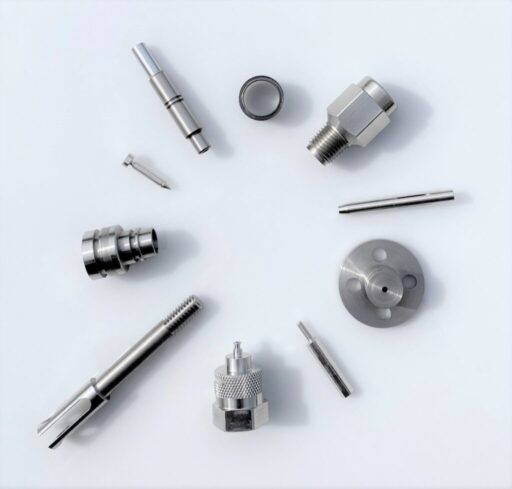
Steel is one of the most commonly used materials in CNC Swiss machining and CNC turning. The main element of steel is iron (coming from iron ore) which is mined in over 50 countries around the world. Currently most the world’s iron ore (over 75%) comes from Australia, Brazil, China, India, Russia, South Africa and the Ukraine (in order of decreasing volume). Australia produces 50% more than any other country in the world (although at one time, China held that distinction).
The combination of iron ore with a variety of other elements in various amounts create various steel types that produce metal with a broad range of physical properties to meet requirements in a wide variety of applications.
The added materials will change the properties of steel (such as flexibility, strength, formability, and hardenability). In general, alloying elements are added in lower percentages (less than 5%) to increase strength or hardenability, or in larger percentages (over 5%) to achieve special properties, such as corrosion resistance or extreme temperature stability.
While there are well over 1000 different variations of steel compositions in existence, for those of us in the precision machining industry (or for those of you that need machined metal components), steels can be grouped into 4 basic categories. From a machining standpoint, the degree of difficulty for machining increases as you move into the next category. At Pioneer Service, most of the machining we do is in the first three categories, with a few projects in the last category.
- Carbon Steels: this variety of steel includes compositions with up to 2-3% carbon. There are low, medium and high carbon steels in this category. The higher the carbon %, the greater the hardness and strength. The steels in this category are generally easy to machine (although they become more difficult to machine as the carbon percentage increases). Steels in this category often require heat treatment after machining to reduce corrosion/weathering. Almost 90% of steel production falls into the carbon steel category.
-
- Example grades of carbon steels**:
- Low: 1010, 1018
- Medium: 1030 and 1040
- High: 1080
- Example grades of carbon steels**:
-
- Alloy Steels: these steels are created by adding various amounts of additional elements to carbon steel. This will produce a steel with added physical characteristics that cannot be found in regular carbon steel. Generally, increased hardness, corrosion resistance and strength are the properties looking to be attained. But a wide variety of elements can be added to achieve a range of improved characteristics, including:
- Manganese, silicon, nickel, and copper are added to increase strength.
- Chromium, vanadium, molybdenum, and tungsten improve appearance.
- Nickel and copper improve corrosion resistance.
- Molybdenum helps to resist embrittlement.
- Zirconium, cerium, and calcium increase toughness.
- Lead, bismuth, selenium, and tellurium increase machinability.
- Examples of Alloy Steels include**:
- 4130, 4140, and 4340
- Examples of Alloy Steels include**:
- Stainless Steels: with stainless steels, chromium is the primary element added to the composition (up to 10-20%). It is used primarily for added visual appearance (think “chrome finish”) and resistance to rust. It is a more expensive material to begin with, and more difficult to machine.
-
- Examples Grades of Stainless Steel**:
- 303, 304 and 316
- Examples Grades of Stainless Steel**:
-
- Tool Steels: this group of carbon steel and alloys are named tool steel because they are most often used to make tools for cutting and shaping other materials. Technically, there are 6 categories of tool steels: water hardened, air hardened, shock resistant, high speed, hot work and special purchase – each with properties and characteristics that allow them to cut, press, extrude and coin other metals and materials. Tool Steels are usually graded by the AISI with a Letter Number (XX) system. Pioneer Service does very little machining of tool steel, but when we do, it is generally cold work material (and usually air hardened medium alloys like A582, A286, A277). Tool steels are extremely difficult to machine.
**Steel numbering system created by the American Iron & Steel Institute (AISI)
The AISI has created a numbering system using 4 digits for identify the composition of the steel:
- First Digit
- 1XXX Any steel that starts with a 1 is a carbon steel
- 10XX= plain carbon steel (with less than 1% Mn)
- 11xx = Re-sulfurized carbon steel
- 12XX = Re-sulfurized and re-phosphorized carbon steel
- 15XX = Non re-sulfurized and high manganese (up to 1.65%)
- 2XXX = Nickel steels
- 3XXX = Nickel chromium steels
- 4XXX = Molybdenum steels
- 5XXX = Chromium steels
- Second Digit:
- Generally, indicates the concentration of the major element (ex: 1=1%, etc)
- Last Two Digits:
- Indicates the carbon concentration (ex: 18 = 18% carbon)
To see some of the many parts that Pioneer Services has manufactured from carbon steel, alloy steel or stainless steel material, please check out our Product Gallery on our website: PioneerServiceInc.com/gallery/. There you can sort by material to see a range of shapes, features, and sizes of components used by clients in a wide range of industries.
To discuss a steel component project that you need precision machined, please contact the Pioneer Service team today!



